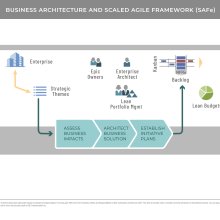StraightTalk has another BFF and it is agile. Here in Post No. 27 we will talk about a hot topic with our guest star, Alex Randell, who gives us the straight talk on what all of this agile stuff means and how business architecture can help. This post is based on our recent interview with him.
Disclaimer: we’ve made some tiny adjustments for our typical StraightTalk-style — the blue headings represent StraightTalk asking the questions and our guest, Alex, responds in turn. The blue italicized text offers additional context and commentary.
Make sure to check out Alex’s interview firsthand in our StraightTalk podcast 5-Minutes With Alex Randell.
Let’s start with the basics. What is agile? What is SAFe?
Alex: “A lot of people are familiar with agile, in many different ways and with many different methodologies. The short version is that agile is an incremental approach to delivery, often focused on software delivery.
SAFe stands for the Scaled Agile Framework.® It is a focused methodology that aligns multiple agile teams as a way to scale an agile approach. Typically this is done in support of common themes and strategies. The SAFe framework and the additional levels that are included in the methodology provide us with additional opportunities to apply more advanced business architecture concepts around strategies and initiatives.
BTW, business architecture can help with any form of agile.”
What are some benefits of agile approaches?
Alex: “I’ve seen a couple key benefits in particular.
One. Agile approaches seem to pull the IT areas and the business closer together. We are increasingly seeing a blurring of the line between “business and IT.” In part the technical resources, often using agile methodologies, have driven this blurring by becoming better versed in what the business is trying to deliver and how the technology supports it. An additional consideration is how business resources need to become more technically proficient as well.
Two. Agile teams seem to have greater ownership, greater mastery and greater focus on the work that they are assigned. This is a common benefit of agile. As the teams become more empowered with ownership of the technical aspects of the business, they also naturally become more focused and accountable for business results.”
How does business architecture work with and provide benefit to agile development?
Alex: “In its simplest form, agile is about getting things done—and business architecture helps us get the right things done. While business architecture focuses on the business, its strategy and how to approach business transformation, agile teams are the mechanism that takes the handoff from business architecture’s strategy to execution methodology and delivers on those business results.
By using the framework that business architecture provides, agile teams can better:
- Identify their work through capability assessments and heatmapping
- Align their work to the value streams and the capabilities of the business
- Measure their results using the business performance framework
In turn, agile teams can provide business architects with a line of sight to the front lines and the experiences of customers and internal stakeholders. This insight can be invaluable to business architects by allowing them to see the real world application of the strategies they facilitate and the framework they develop.”
See below for a handy diagram which shows where business architecture fits within the SAFe framework.
Business architects work at the portfolio level and focus on:
- Informing prioritization
- Providing business context and framing for work
- Providing a common vocabulary and mental model
- Connecting dots across the enterprise related to business direction and initiatives
Some people have concerns that business architecture may slow down the agile development process. How would you respond to this?
Alex: “Agile is great at getting beyond processes with a focus on working software from the Agile Manifesto. Applying business architecture does not—or perhaps should not—get in the way of that progress. Rather, business architecture applied to agile programs helps teams by setting a foundation, focusing them on the highest priority capabilities and work, and assuring alignment to strategies of the business.
So, does business architecture slow down agile teams? Not if applied correctly. Business architecture doesn’t get in the way of the team, but rather works alongside to help them be best focused and prepared—which speeds things up rather than slowing them down. And, it ensures that the agility and the success of the team is applied to the highest value parts of the business.
You know we have to ask. What’s your six-word memoir for how business architecture benefits agile approaches?
You know we have to ask. What’s your six-word memoir for how business architecture benefits agile approaches?
Alex: “Business architecture, one of Agile’s BFFs.”
Anything else?
Alex: “The story really isn’t complete. Even though we’ve been working on agile and business architecture for years now, we’ve really just started writing the story. Business architecture and agile are two exciting parts of our world, and there are many opportunities to contribute to the thought leadership, methodologies and stories of success related to how they align and benefit our organizations.”
More Good Stuff…
5-Minutes With Alex Randell (StraightTalk podcast): Just in case you missed that link right there in the beginning, check out the podcast where Alex talks to us about how business architecture and agile approaches relate, which was the basis for this post.
Leveraging Business Architecture to Improve Business Requirements Analysis (Business Architecture Guild® White Paper): A Guild white paper that describes how business architecture and requirements work together. (See Business Architecture Guild®Public Resources page.)
Business Architecture and Agile Methodologies (Business Architecture Guild® White Paper): A Guild white paper that describes how business architecture and agile methodologies work together. (See Business Architecture Guild®Public Resources page.)
Aligning Business Architecture and the Scaled Agile Framework® (Business Architecture Guild® White Paper): A Guild white paper that reconciles the terms value stream and capability between business architecture and SAFe. (See Business Architecture Guild®Public Resources page.)
Requirements Team Blog (Business Architecture Guild®): Some fantastic posts from Guild members on business architecture and agile approaches.
From Strategy to Agile Stories: An Epic Journey (Business Architecture Guild® webinar): A great webinar on business architecture and SAFe. (Business Architecture Guild® membership required.)
Business Architecture and Requirements Alignment (Section 3.8 of the BIZBOK® Guide): Here’s the official word on the topic of business architecture and requirements. (Business Architecture Guild® membership required.)
SAFe 4.0 in 5 Minutes (Video): Here’s a quick animated video introducing the Scaled Agile Framework (SAFe), version 4.0.
5 Non-Agile TED Talks About Agile (TED Talks): Here are five great talks that were not originally about agile concepts, but unexpectedly teach us much about them. Find out what we can learn from neuroscience, animated movies and even semi-intelligent slime.

